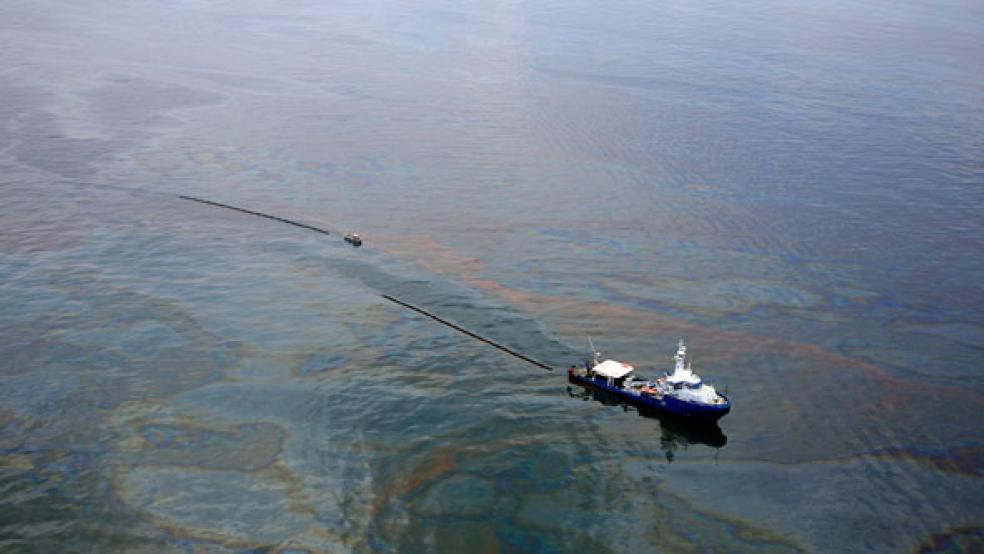If all goes well over the next few days — and fingers are crossed around the globe — BP will finally begin stanching the flow of oil and gas that has been pouring from the Deepwater Horizon spill in the Gulf of Mexico since April 20. More than six million gallons of oil have so far entered the Gulf (though scientists say the real number is far higher).
The method BP is now planning to use on Tuesday is called a top kill. It sounds powerful and could be a better solution than the mile-long tube inserted into a leaking pipe last week that is now capturing 2200 barrels a day—less than half of BP’s first estimate of 5,000 barrels a day.
On Friday, President Obama announced a new bipartisan national commission to look into the causes of the horrific spill, naming two veteran officials as co-chairmen — Bob Graham, former senator from Florida, and William K. Reilly, former EPA administrator. “I want to know what worked and what didn’t work in our response to the disaster, and where oversight of the oil and gas industry broke down,” Obama said on Saturday. Still, he has not backed down from a plan to expand offshore oil drilling, saying that the Gulf of Mexico “represents 30 percent of our oil production” and can play an important part in securing our energy future.”
As the disaster pushes past the 30-day mark, and as anger and dismay pour from fishermen, scientists, conservationists and others across the nation who fear for imperiled coastlines and wildlife, here’s a look at the latest news, through a glossary of essential Gulf oil-spill terms:
TOP KILL: It’s unproven, untested, and unprecedented at depths of 5,000 feet. The procedure involves pumping a heavy stream of liquid into the well head to block the oil and water that’s flowing into the broken riser pipe feeding the spill. Cement would then be forced into the well hole, to completely and permanently seal it. BP plans to begin the procedure on Tuesday.
BP is also continuing to drill a relief well, which is viewed as the ultimate solution to the spill. But this past Friday, Doug Suttles, chief operating officer of BP, told the CBS “Early Show” that in the worst-case scenario, oil could continue to gush until early August, when the new well is finally finished.
Meanwhile, questions swirl about the top kill. As Peter Fairley notes in MIT’s Technology Review, “It is the most invasive maneuver to date, and [it] could rupture the leaking well and actually accelerate the flow of crude.”
JUNK SHOT: The name ‘junk shot’ doesn’t exactly inspire confidence, but if the top kill doesn’t work, BP officials may try it. The procedure essentially propels a mix of materials—golf balls, churned-up rubber tires, and knotted rope, among others—into the blowout preventer on top of the well to help stop the flow of oil.
It’s as unruly as an underwater landfill, but the method has plugged other wells successfully in the past. At 5,000 feet below the surface, however, this manuever has never been tried before, so its outcome remains uncertain.
LOOP CURRENT: Government scientists determined on FRIDAY that a portion of the oil slick had entered this powerful mass of water that flows around the central Gulf of Mexico and up through the Florida Straits. From there, the loop joins the Gulf Stream, which travels up the eastern coast of the U.S.
Even AccuWeather has gotten into the game: “In addition to the concern now for oil showing up in great quantities in the Keys, the Florida west coast, Cuba, and the Yucatan Peninsula of Mexico, part of the slick could be drawn into the Gulf Stream, then perhaps northward to part of the Atlantic Seaboard of the United States,” it noted on its website.
The loop current is so fast-moving and unpredictable that officials had long been worrying it might pick up the oil and carry it out beyond the Gulf of Mexico. Still, much remains unknown. “It moves every day,” Chuamin Hu, associate professor of optical oceanography at the University of South Florida, told the Tampa Tribune. The loop is nudged along by strong winds and other environmental factors. Meteorologists and others will continue to watch it closely.
SPILL CAM: Hundreds of thousands of people tried viewing a riveting new live video feed of the oil spill posted on a House committee’s website early on Thursday. The traffic was so heavy that the site crashed.
The live feed was requested in letters to Lamar McKay, chief executive of BP, from Massachusetts Representative Edward Markey, who is chairing the House Select Committee on Energy Independence and Global Warming. “This may be BP’s footage, but it’s America’s ocean,” Markey said in a statement. “Now anyone will be able to see the real-time effects the BP spill is having on our ocean.” The feed is up and running again, though access remains spotty because of the high volume of users. In a message posted on Twitter, Markey urged people to keep trying to view it.
BP released a statement on Friday saying that it, too, would make the live video available on its website, where, presumably, they have more bandwidth. The spill cam shows a large, dark, and awful plume of oil and gas billowing out of several breaks in an oil pipe.
OCEAN THERAPY: This week, in the continuing search for solutions, BP and the U.S. Coast Guard will begin testing actor Kevin Costner’s stainless steel centrifugal oil separator, known as Ocean Therapy. It’s a technology the Oscar-winning director has invested 15 years and roughly $24 million of his own money in, according to reports. He began working on the device, which is essentially a huge vacuum cleaner loaded on a barge, while making his 1995 film, Waterworld.
“Hey, some of the best ideas sometimes come from the strangest places,” actor Stephen Baldwin told the Los Angeles Times. Baldwin is said to be making a documentary about the oil spill and Costner’s machine.
Costner’s business partner, Louisiana attorney John Houghtaling, told the Los Angeles Times that Costner bought the technology after the 1989 Exxon Valdez disaster. From there, he asked scientists and engineers to help develop it further. Costner reportedly has 300 Ocean Therapy machines of many sizes.
Please tell us what you think about this story. Use the comment box, below.
Related Links:
BP Oil Spill: 7 Secrets BP Doesn't Want You To Know – Huffington Post
BP Oil Spill: Oil Hits Louisiana Wetlands, Causes Spike in Seafood Prices - ABC News
Deepwater Horizon rig: What went wrong? - MSNBC
Louisiana Oil Spill 2010 PHOTOS: Gulf Of Mexico Leak Reaches Land - Huffington Post
New Setback in Attempt to Contain Gulf Oil Spill - The New York Times


